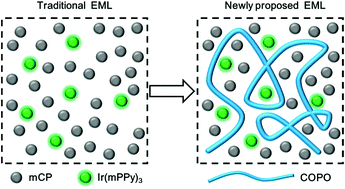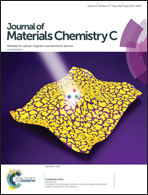Efficient triplet utilization in conventional solution-processed phosphorescent organic light emitting diodes using a thermal activated delayed fluorescence polymer as an assistant host†
Abstract
Solution processed Ir(mPPy)3 based phosphorescent organic light emitting diodes (PhOLEDs) were fabricated, in which mCP and a TADF copolymer, COPO, were selected as host and assistant host components, respectively. The COPO has a lower triplet energy and a higher singlet energy than Ir(mPPy)3. Compared with traditional Ir(mPPy)3 doped mCP type PhOLEDs, the introduction of COPO as an assistant host can effectively improve the electroluminescent performance. Utilizing 20% COPO and 70% mCP (w/w) as a mixed-host system for Ir(mPPy)3 in solution-processed devices, a considerably higher current efficiency of 56.8 cd A−1 has been achieved with great improvement, compared to traditional Ir(mPPy)3 based devices with mCP as the single host (24.5 cd A−1). Moreover, the EQE displays only a slight roll-off from an EQEmax of 17.3% to an EQE of 16.0% at 500 cd m−2. The improved PhOLED performance is mainly attributed to the full utilization of triplet excitons as COPO may facilitate the triplet transfer due to a closer physical contact with mCP and Ir(mppy)3 molecules. Moreover, the presence of COPO also improves the ambipolar transport of charge carriers.



 Please wait while we load your content...
Please wait while we load your content...